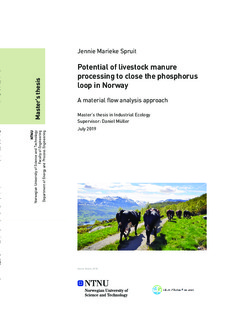| dc.description.abstract | Norway is dependent on imports of mineral fertiliser in the form of phosphate rock, which is a scarce and non-renewable resource, but has sufficient phosphorus (P) available in the form of manure to cover the national demands for food production. The use of this secondary source of P requires its transport between regions, due to the spatial heterogeneity in animal and crop farming, which is made difficult by the heavy weight of manure. A new technology termed CowPower™ aims to address this issue through the processing of livestock manure, creating a lightweight P-rich product which can be exported to P deficient regions. A material flow analysis (MFA) of this technology was conducted, along with an MFA of a Norwegian organic farm. Subsequently, these were combined in an upscaling scenario to assess the potential quantity of cattle manure available for processing on a national scale, while accounting for current reuse of manure to produce forage feed, and the unavailability of manure excreted during grazing. CowPower was found to produce a final exportable product containing 70% of the manure P and merely 2.5% of the wet weight, along with a liquid N-rich fertiliser for use on-farm. The organic farm was found not to have a surplus of P, due to its strong reliance on homegrown feed. Out of a total manure P production of 9 kt per year from cattle, 1.3 kt P remained after deduction of losses to pasture and fertilisation of forage crops. After CowPower treatment this would yield 0.8 kt P (weighing 53 kt) in the dry fraction for transport, the plant fertilisation potential of which is unknown. We conclude that the manure share requiring interregional transport is less than anticipated, as efficient recycling into forage crops should be prioritised. Barriers to efficient local recycling should be further analysed to assess CowPower’s role in overcoming these. | |
